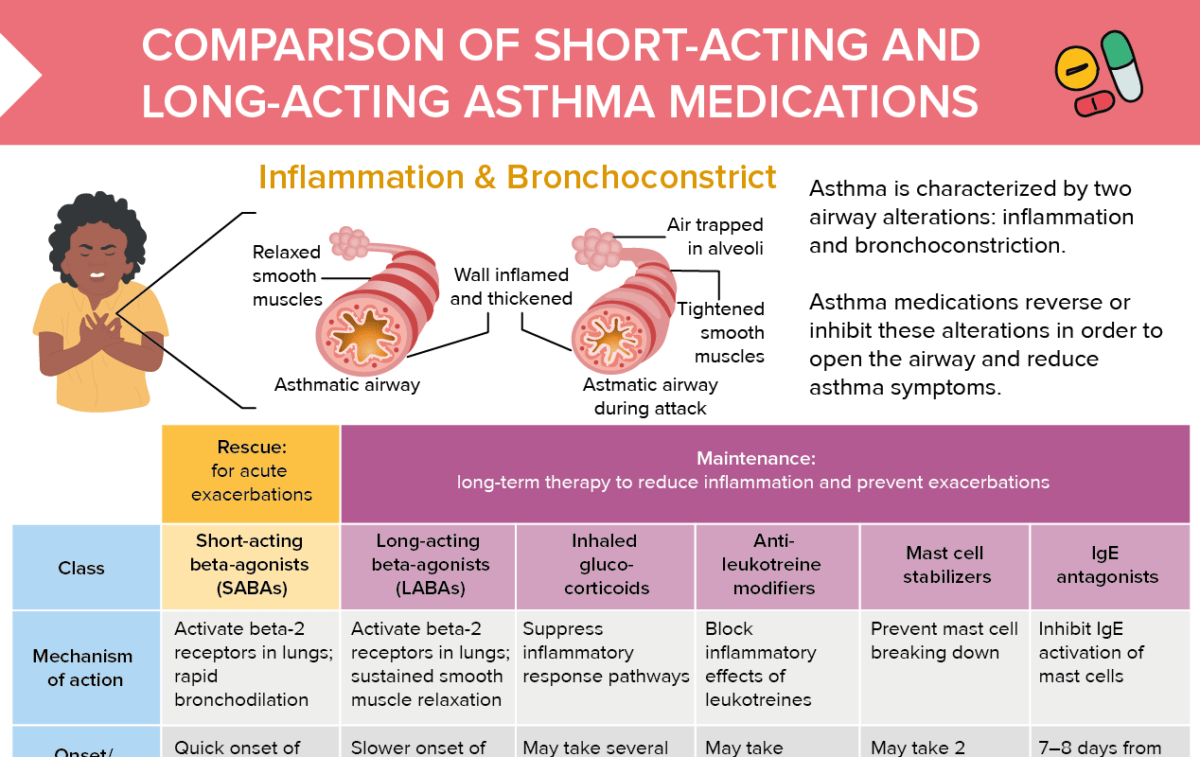SABA vs LABA: at a glance
In short: SABAs are rescue asthma medications used to quickly relieve acute exacerbations, while LABAs are for continuous treatment of asthma with the main goal of preventing or lessening exacerbations.
What are LABA medications?
LABAs stands for long-acting beta-agonists. LABAs are used (inhaled) as long-term asthma therapy to reduce inflammation and prevent exacerbations. They have a slower onset of action and the effects last about 12 hours. Medications in this class include:
- Arformoterol
- Formoterol
- Indacaterol
- Salmeterol
LABA mechanism of action
LABAs activate beta-2 receptors in the lungs and lead to sustained smooth muscle relaxation.
What are SABA medications?
- SABAs stands for short-acting beta-agonists. SABAs have a quick onset of action, but the effects only last for about 4 hours. They are used to help with acute exacerbations of asthma, and referred to as a “rescue inhaler”. Medications in this class include:
- Albuterol
- Levalbuterol
SABA mechanism of action
SABAs activate beta-2 receptors in the lungs and lead to rapid bronchodilation.
What are SABAs and LABAs used for?
SABAs and LABAs are bronchodilators primarily used for treating asthma, COPD, and other respiratory conditions.
Asthma is characterized by two airway alterations: inflammation and bronchoconstriction. Asthma medications reverse or inhibit these alterations in order to open the airway and reduce asthma symptoms.
Other maintenance asthma medications
- Inhaled glucocorticoids:
- Suppress inflammatory response pathways
- May take several days to weeks to note improvement
- Medications: beclomethasone, budesonide, flunisolide, fluticasone
- Route: inhaled
- Anti-leukotriene modifiers:
- Block inflammatory effects of leukotrienes
- May takes several weeks to note benefit
- Medications: montelukast, zafirlukast, zileuton
- Route: oral
- Mast cell stabilizers:
- Prevent mast cell breaking down
- May take 2 days–2 weeks to note benefit
- Medications: cromolyn
- Route: inhaled
- IgE antagonists:
- Inhibit IgE activation of mast cells
- 7–8 days from start of injections to clinical benefit
- Medications: omalizumab
- Route: subcutaneous
SABA and LABA medication client education
Rescue vs maintenance
Explain the action of each medication in the treatment plan, the difference between short- and long-acting medications, and when to use each.
Proper administration
Demonstrate use of the client’s inhaled medication device, including spacer use if indicated. Verify understanding through the teach-back method.
Signs of uncontrolled asthma
Adjustments to the treatment plan may be needed if symptoms are not controlled.
Educate clients to report:
- More than two exacerbations per week
- Increased use of rescue inhaler
- Frequent nighttime awakening
